Meilleures notes
Essayer d'abord, étudier ensuite !
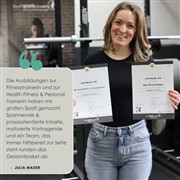
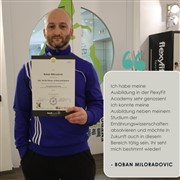
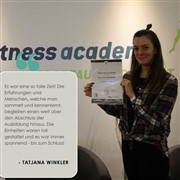
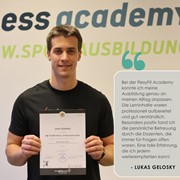


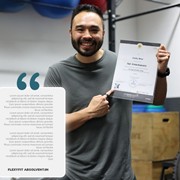
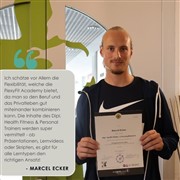
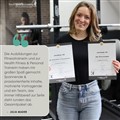
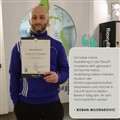

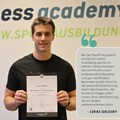


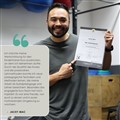
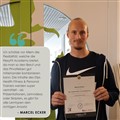

€ 2.890,- | Cours individuels
» Notre siteDossiers pédagogiques
Informations sur la formation
Reconnu & certifié
Nos diplômés, partenaires & amis disent
Notre équipe se fera un plaisir de vous conseiller à tout moment par téléphone, chat ou en personne.
Le stress est un problème omniprésent dans notre société. De nombreuses personnes souffrent de surmenage et ne savent pas comment y faire face. En tant que formateur en relaxation, vous pouvez aider vos clients à gérer et à prévenir le stress.
Dans cette formation, vous apprendrez tout ce que vous devez savoir sur le stress et la manière de le combattre, les différents types de stress, ainsi que de nombreuses techniques de relaxation différentes qui aideront vos clients à se détendre. .
Après la formation de formateur en relaxation, vous travaillerez avec des personnes individuelles ou des groupes et leur montrerez comment lutter contre le stress au travail et dans la vie quotidienne.
Si vous souhaitez élargir vos connaissances aux domaines de l'entraînement de la colonne vertébrale et de l'alimentation, la formation supérieure d'entraîneur diplômé Vital et santé vous conviendra parfaitement. Outre le module d'entraîneur de relaxation, cette formation comprend en plus les deux formations d'entraîneur de la colonne vertébrale et d'entraîneur en nutrition avec tous leurs contenus intéressants et instructifs.
Volume d'apprentissage
728 E
Niveau EQF
La formation s'oriente vers Niveau EQF 4 »
Début des cours
Possible immédiatement
Variante d'apprentissage
Cours individuels

| 29-12-2025 | € 2.390,-
| 29-12-2025 | € 2.390,-
| 29-12-2025 | € 2.390,-
| 29-12-2025 | € 2.390,-

En tant que formateur en relaxation, vous montrez comment créer un équilibreentre la tension et la détente, l'activité et le repos, l'excitation et la récupération. Vous apprenez à reconnaître les besoins individuels de vos clients et maîtrisez un large éventail de techniques et de méthodes pour concevoir et réaliser des entraînements de détente efficaces .
Notre formation de formateur en relaxation est axée sur la pratique et vous donne les connaissances nécessaires pour faire face à la demande sans cesse croissante d'offres de santé alternatives . En tant que formateur en relaxation formé, apportez plus de sérénité dans votre vie et dans celle de vos clients.
Au cours de la formation de formateur en relaxation diplômé, vous apprendrez différentes méthodes de relaxation. Celles-ci sont classées en fonction du niveau musculaire, végétatif et cognitif.
Vous apprendrez ainsi le training mental et autogène, les exercices de base du yoga et du pilate, ainsi que la relaxation musculaire progressive. Nous vous montrerons différentes possibilités de mesures d'auto-assistance en cas de douleurs dans la colonne vertébrale et comment vous pouvez assister les clients lors du stretching. Nous enseignons également les principales connaissances théoriques de base sur la respiration, et nous présentons et pratiquons de nombreux exercices pratiques de respiration.
Les contenus théoriques que vous aborderez incluent la théorie du stress - de la biologie du mécanisme du stress aux techniques de gestion du stress. Dans la matière Conception et planification des cours, vous apprendrez la structure et la planification d'un cours de relaxation.
Nous vous montrerons en outre quels sont les liens entre la détente et le sport d'endurance ou l'alimentation.
Nos certificats sont valables dans le monde entier et sont délivrés dans différentes variantes. Si vous le souhaitez, vous pouvez obtenir notre certificat en plusieurs langues (DE, EN, ES), avec des informations spécifiques à chaque pays et avec ou sans impression des notes.
Toutes ces variantes sont disponibles gratuitement à vie en téléchargement sur votre campus en ligne. En outre, selon le package d'apprentissage que vous avez acheté, vous recevrez un certificat de votre choix, délivré sur un papier spécial de haute qualité avec impression en relief.
Le certificat suivant (en plusieurs langues DE, EN, ES) vous sera délivré :
Nous nous ferons un plaisir de vous aider par téléphone, par e-mail ou par chat . Mais vous trouverez peut-être la réponse à votre question dans notre FAQ générale ou dans notre FAQ des entraîneurs de relaxation.
Volume d'apprentissage
200
Compétence sportive
446
Présence | Auto-apprentissage
12
Recherche documentaire
60
Mise en ouvre pratique
10
Tâches supplémentaires & examens
Nos formations sont en principe éligibles à des subventions. C'est l'organisme de financement compétent qui décide si vous pouvez bénéficier d'une subvention.
Nous vous aidons volontiers à rassembler toutes les informations sur les cours dont vous avez besoin pour votre demande de subvention.
Nous sommes bien entendu à vos côtés pour vous conseiller tout au long du processus et vous accompagner de la première demande jusqu'au dépôt de votre demande. Contactez-nous - nous veillerons à ce que vous soyez préparé au mieux !
Afficher tous les chapitres des matières

Nous formons les meilleurs entraîneurs dans le secteur du fitness. Nous accompagnons et encadrons nos diplômé(e)s du début à la fin et au-delà.
L'anatomie fonctionnelle est la base de tout entraîneur dans le domaine du sport et de la santé. Ce cours spécialisé vous donne un aperçu complet de l'anatomie du corps humain et vous permet ainsi d'acquérir des connaissances approfondies.
Le cours est conçu de manière aussi vivante et compréhensible que possible, à l'aide de différentes techniques d'enseignement et d'apprentissage - adaptées aux besoins des entraîneurs de fitness et personnels.
L'objectif est d'identifier les relations entre les mouvements et de comprendre les principaux termes techniques latins.

Dans le cadre de la nutrition sportive générale, nos participants sont initiés aux principes de base de la nutrition.
La composition de notre alimentation en macro- et micronutriments ainsi que l'équilibre hydrique sont abordés comme base. Afin de comprendre les différentes relations, l'équilibre énergétique est abordé en détail.
En outre, l'effet des différents composants alimentaires sur le corps humain ainsi que leur importance dans le domaine sportif seront abordés.

Comme les blessures sont monnaie courante dans le sport, il est important de connaître les causes et les conséquences des blessures les plus fréquentes. En cas de problème, le personal trainer doit pouvoir réagir rapidement et correctement !
De plus, la compréhension des différents types de blessures permet de les éviter de manière préventive.

Dans de nombreuses entreprises, la promotion de la santé au travail est désormais une méthode très appréciée pour renforcer la santé des collaborateurs, prévenir les maladies et ainsi renforcer le bien-être des employés.
Les raisons pour lesquelles la promotion de la santé en entreprise est si importante sont expliquées dans une introduction à la promotion de la santé en entreprise, les défis de la promotion de la santé en entreprise sont présentés et les maladies organisationnelles courantes sont abordées.
En outre, les participants au cours apprennent quels sont les facteurs de réussite de la promotion de la santé au travail, quels sont les avantages pour les travailleurs et l'entreprise et, bien sûr, quelles sont les procédures et les instruments qui ont fait leurs preuves.
Différents domaines d'activité et mesures sont présentés et les participants au cours reçoivent des explications sur la manière d'entrer dans de telles entreprises, d'élaborer des concepts et de clarifier d'autres aspects organisationnels importants.
Des exemples pratiques sont présentés aux participants, qui ont également la possibilité d'appliquer ce qu'ils ont appris dans le cadre d'un travail de groupe.

L'unité Travail orienté vers le client a pour but de donner aux participants un aperçu du marketing, afin qu'ils puissent se positionner sur le marché en tant qu'entraîneur et que leur entrée sur le marché soit facilitée.
Pour ce faire, nous commençons par définir ce qu'est le marketing et pourquoi il est également pertinent pour les entraîneurs personnels.
En outre, les termes techniques courants du marketing tels que l'USP, les avantages, le positionnement, etc. sont expliqués, ainsi que différents modèles de marketing tels que la formule SMART, le marketing mix 4P et d'autres.
La communication entre le formateur et les clients n'est évidemment pas oubliée dans cette unité. Différents aspects de la communication ainsi que les règles d'une communication réussie sont introduits et des exemples sont présentés.
A la fin de cette unité, les participants devraient être en mesure de se positionner sur le marché et de vendre avec succès leur produit ou service à l'aide d'une stratégie de marketing.

Une bonne connaissance de la physiologie humaine et des fonctions qui y sont liées dans le corps est une condition nécessaire à l'exercice adéquat de la profession d'entraîneur dans le domaine du sport.
Ce cours vous permettra de"comprendre" les interactions de l'organisme humain. Voyagez avec nous à travers le corps humain et comprenez les fonctions de l'organisme pour votre nouveau profil professionnel dans le sport.
Dans la matière enseignée, nous explorons de manière aussi pratique et passionnante que possible la mise à disposition d'énergie du muscle, le système cardiovasculaire et le système respiratoire.
Une bonne formation sportive commence à la base avec l'anatomie et la physiologie.

Dans ce cours, les participants sont préparés à communiquer avec succès avec le client à tous les niveaux. En outre, les participants sont invités à réfléchir à leurs propres objectifs et motivations afin de mieux comprendre ceux des clients.
Fixer des objectifs et donner un feedback correct font également partie du cours !
La gestion du stress et différentes stratégies d'apprentissage sont également présentées aux participants afin qu'ils puissent les appliquer après la formation.

Dans la première partie de la théorie de l'entraînement, les bases de l'entraînement sont enseignées, comme les principes d'entraînement, les principes de conception de l'entraînement, les méthodes d'entraînement et les facteurs de la performance sportive.
Comme la performance, le diagnostic de la performance, l'entraînement et la compétition sont en étroite interaction, ils sont également enseignés en conséquence dans le cours.
Dans la deuxième partie de la théorie de l'entraînement, l'entraînement est défini et évalué en tant que processus d'action complexe et en relation avec la planification, l'exécution et l'évaluation.
Une partie importante de la théorie de l'entraînement est toujours la conception du plan d'entraînement, qui est enseignée de manière pratique avec des exemples sur les possibilités de conception d'un plan d'entraînement.
Afin d'aller encore plus loin dans la science de l'entraînement, nous avons collaboré avec des intervenants internationaux de premier plan tels que le Prof. em. Dr. med. Dr. h.c. Jürgen Weineck, un atelier vidéo sur le thème de l'entraînement en altitude.
Afficher tous les chapitres des matières

L'unité Entraînement de la flexibilité et stretching assisté est divisée en trois parties : Entraînement de la flexibilité, Stretching assisté et Entraînement des fascias.
Entraînement de la flexibilité
L'entraînement de la flexibilité comprend une définition de la flexibilité et de la souplesse. Ensuite, il explique la souplesse et la capacité d'étirement. L'importance de la flexibilité pour le sport et pour la détente est abordée et on détermine ensuite de quoi dépend la flexibilité et, inversement, ce qui dépend de la flexibilité.
Des termes techniques tels que "tonus musculaire" sont introduits et mis en relation avec la détente.
En outre, il est question de ce dont dépend la capacité d'étirement et les différentes méthodes d'étirement telles que l'étirement statique et l'étirement dynamique ainsi que l'étirement actif et passif sont expliquées.
L'utilité des étirements est abordée, mais aussi les capacités qui leur sont attribuées à tort.
Les participants au cours apprennent en outre différents exercices d'étirement pour différentes parties du corps.
Étirement assisté
L'assisted stretching en tant que technique de mobilisation et d'étirement est également introduit dans cette unité et il est fait référence à la manière dont l'assisted stretching peut être utilisé dans la pratique. A cet effet, les participants au cours reçoivent une check-list sur laquelle figurent les éléments à prendre en compte lors d'une séance.
Les contre-indications qui interdisent l'assisted stretching sont également abordées.
Entraînement des fascias
L'entraînement des fascias est également abordé dans le cadre de cette unité. La nature des fascias et la manière dont ils peuvent être entraînés seront abordées. Des exercices pratiques d'étirement des fascias seront présentés et la manière dont un entraînement des fascias peut se dérouler sera démontrée.


Il existe un certain nombre de types différents de méthodes de relaxation que les gens peuvent utiliser pour se détendre. L'une de ces méthodes est le sport d'endurance.
Avec la méditation et le training autogène, le sport d'endurance est l'une des méthodes de relaxation les plus connues et les plus populaires. De nombreuses personnes apprécient les activités d'endurance comme une compensation bénéfique à une journée de travail épuisante.
Les sports d'endurance sont un excellent moyen de se détendre et de maintenir son corps en forme. Bien sûr, les sports d'endurance nécessitent un effort préalable, mais de nombreuses études montrent que les sports d'endurance peuvent contribuer à réduire le stress et la tension. L'effort physique entraîne la libération d'endorphines qui réduisent le stress et entraînent un sentiment de satisfaction.
C'est à chacun de tester le sport qui lui convient le mieux pour se détendre. En général, les sports d'endurance tels que la course, la marche nordique, la natation ou le vélo conviennent bien. Le vélo permet de ménager les articulations. En natation, la sensation d'être porté par l'eau soulage également.
Dans cette matière de la formation d'entraîneur de détente, les différents effets des sports d'endurance sur la détente sont mis en lumière d'un point de vue scientifique et des instructions concrètes sont données pour l'utilisation des sports d'endurance pour la détente.


La colonne vertébrale est la structure centrale du corps et est soumise à une alternance constante de contraction et de détente. La musculature et le tissu conjonctif doivent s'adapter à cette alternance et se reposer à intervalles rapprochés. Des exercices de relaxation ciblés après l'entraînement permettent à la colonne vertébrale de se soulager et à la musculature de se détendre.
Après un effort physique, il est donc important d'accorder suffisamment de temps et de repos au corps pour qu'il puisse se régénérer. Mais en même temps, il est également important que le corps ne soit pas constamment dans un état de tension, car cela peut conduire à une surcharge.
L'exercice et la détente sont indispensables à la santé du corps. L'exercice physique est une activité indispensable à la santé du corps. Il aide non seulement à la digestion, mais aussi à la circulation sanguine et à l'augmentation du métabolisme. La relaxation qui suit est tout aussi importante, car elle détend les muscles et favorise ainsi la circulation sanguine. Les tissus peu irrigués, tels que les disques intervertébraux, le cartilage articulaire et l'appareil capsulo-ligamentaire, sont particulièrement tributaires d'un exercice dosé suivi d'une relaxation afin d'obtenir une alimentation optimale et une augmentation du métabolisme.
Il est important à cet égard de laisser l'entraînement se terminer lentement. La détente commence par la tête. Il faut également essayer de se déconnecter mentalement.
Outre les causes possibles de douleurs dans la colonne vertébrale dues au stress, vous apprendrez dans cette matière du cours de formateur en relaxation différentes possibilités de mesures d'auto-assistance. Les différentes techniques de perception et de relaxation ainsi que leurs objectifs et leur mise en ouvre seront également abordés.
Ce cours s'adresse à tous ceux qui ont souffert jusqu'à présent de douleurs dans la colonne vertébrale et qui souhaitent trouver une solution. Il s'adresse également à tous ceux qui s'intéressent aux différentes techniques de relaxation et de perception.


L'importance et l'utilité de l'entraînement mental ont fait leur apparition dans de nombreux domaines au cours des dernières décennies, que ce soit dans le sport, pour le travail ou dans la vie privée.
L'entraînement mental fait appel à différentes techniques pour optimiser la concentration et les performances de chacun. Des techniques telles que le training autogène, la visualisation, l'entraînement à la fixation d'objectifs, etc. permettent d'identifier et d'exploiter des potentiels non découverts.
Dans le domaine de la détente, l'entraînement mental aide à ralentir le processus de pensée infatigable, à mieux le comprendre et à rendre ainsi la détente possible. Le cours est divisé en parties théoriques et pratiques, laissant une large place à l'expérience personnelle.

Dans la matière Exercices de base Pilates de la formation Entraîneur de relaxation, la première partie est consacrée à l'histoire et aux concepts de base de la méthode Pilates.
Outre la partie théorique, une attention particulière est accordée à l'expérience personnelle de cette méthode. L'apprentissage d'exercices Pilates typiques permet d'expérimenter les effets de cette méthode sur le corps humain.
La méthode Pilates a été développée à l'origine par Joseph Pilates. Cette méthode vise à renforcer les muscles profonds et à améliorer ainsi la posture et la mobilité. Il existe de nombreux exercices qui peuvent être effectués de différentes manières.
Le Pilates convient aussi bien aux débutants qu'aux avancés et peut être pratiqué à la maison ou dans un studio. Il s'agit d'une méthode d'exercice physique et mental qui a été développée à l'origine pour la rééducation après des blessures. Elle permet d'améliorer la perception de soi au niveau physique et mental. Le Pilates est un bon moyen de remettre le corps en forme et de renforcer la musculature.
Le concept Pilates convient également comme méthode de relaxation, car il peut être adapté individuellement à chaque niveau de performance. Les exercices n'ont pas d'effets négatifs sur le corps, c'est pourquoi le Pilates convient également aux personnes âgées et aux personnes souffrant de problèmes de dos.



De nos jours, la détente est plus importante que jamais dans notre monde trépidant et agité. De nombreuses personnes se plaignent de stress et de nervosité et sont donc à la recherche de techniques de relaxation pour mieux gérer leur stress quotidien.
Le bon formateur en relaxation peut faire une grande différence et aider à apprendre et à utiliser les bonnes techniques.
La conception et la planification des cours sont des éléments essentiels du travail d'un instructeur de relaxation. Dans la première partie de la matière "Conception des cours ", nous nous pencherons sur les principes didactiques les plus importants et nous nous demanderons comment une unité peut être construite et quelles conditions nécessaires doivent être prises en compte pour créer la bonne ambiance et le bon climat pour les participants. Le formateur doit être en mesure de trouver le bon équilibre entre tension et détente et les participants doivent se sentir à l'aise.
Chaque heure de cours a un concept clair, une structure bien pensée et un objectif à atteindre. Au début du cours, le concept du cours doit être communiqué aux participants afin qu'ils puissent s'adapter au cours. Celui-ci peut être corrigé ou légèrement modifié pendant le cours. Ainsi, les participants peuvent se détendre à chaque cours et adapter les exercices de manière optimale à leurs besoins.
L'entraîneur doit "vivre" la détente: il doit pouvoir la transmettre aux autres et véhiculer les sentiments correspondants. Il doit lui-même rayonner de calme et de sérénité.
Le cours ne transmet pas seulement des connaissances théoriques complètes, mais aussi les compétences pratiques nécessaires pour concevoir une séance de relaxation.
Dans la deuxième partie principale de ce cours, les participants peuvent présenter leurs concepts de cours et reçoivent ensuite un feedback constructif de la part des enseignants ainsi que des autres participants du cours.

Qu'est-ce que le yoga et d'où vient-il ? Le yoga est un enseignement indien issu à l'origine de l'hindouisme. Le message clé du yoga est le suivant : "Par la pratique et l'habitude, on peut connaître le monde". Le yoga se pratique seul ou en groupe et se compose de différentes techniques corporelles, de respiration et de méditation.
Les premières traditions du yoga datent du 2e et du 1er siècle avant Jésus-Christ et sont consignées dans ce que l'on appelle les Vedas, les écrits sacrés de l'hindouisme. Le yoga est une philosophie indienne très ancienne qui vise à l'unité du corps, de l'esprit et de l'âme.
La pratique du yoga comprend différents exercices, techniques de respiration et méditations qui doivent contribuer à renforcer le corps et à apaiser l'esprit.
Dans cette matière de la formation de formateur en relaxation, nous nous pencherons sur quelques exercices de base du yoga qui se concentrent principalement sur la relaxation et le renforcement du corps. Nous nous pencherons également sur l'histoire et la philosophie du yoga et apprendrons comment cette tradition ancestrale a perduré jusqu'à nos jours.
Dans la partie principale, nous enseignerons des positions de yoga choisies en mettant l'accent sur la relaxation. L'expérience personnelle, ainsi que l'instruction et la correction des exercices de yoga choisis, sont au centre de la formation.
Variantes d'apprentissage disponibles pour cette formation
Langue d'enseignement
Module spécialisé
Compétence sportive (en ligne)
Compétence sportive (présence)
Compétence sportive Vidéos d'apprentissage Full HD
Module spécialisé Vidéos d'apprentissage Full HD Détente
Formation incluse
Variante d'apprentissage
Méthode d'apprentissage
type d'apprentissage auditif & visuel
type d'apprentissage communicatif & moteur
Temps d'apprentissage
Scripts & documents en PDF
Possibilité de comptabiliser les cours comme journées pratiques
Support via campus en ligne, eMail, chat, tél.
Assistance WhatsApp & sur place
Examens blancs
NADA Autriche
Entraînement en altitude - Prof. DDDr. Weineck
Examen intermédiaire SPK en ligne
Examen final
Certificat en DE, EN, SP
Certificat valable dans le monde entier & sans limite de temps
Campus en ligne Disponible à vie
Compte de démonstration gratuit / pack découverte
Copies d'actes téléchargeables au format PDF
Certificats avec vérification de l'authenticité (code QR)
Possibilités de financement
Congé de formation (AT)
Promotion des entreprises
Soutien aux indépendants
Conseil en matière de formation
Devis pour l'organisme de financement
Service de placement
des offres de formation continue étendues
Meilleur prix absolu & offre de prestations
FR
En ligne + entretien professionnel
en ligne
Possibilité d'inscription en option
314
217
Licence B
en ligne
visuel
recommandé
approprié
flexible
comptabilisable
délai flexible
jusqu'à 100
sans engagement
FR
Cours de présence en groupe
Cours de présence en groupe
Possibilité d'inscription en option
314
comptabilisable
Licence B
présence
motorisé
approprié
recommandé
Dates
comptabilisable
délai flexible
jusqu'à 100
sans engagement
DE, EN
Cours individuels
en ligne
contiennent
314
217
Licence B
One2One
visuel/moteur
approprié
recommandé
individuel
contiennent
individuel
jusqu'à 100
sans engagement
Il existe de nombreuses possibilités de financement pour les formations dispensées par la Flexyfit Sports Academy. Les subventions spécifiques aux Länder et à l'UE ainsi que les possibilités fiscales constituent la base de ces aides.
Nous attirons toutefois votre attention sur le fait que la décision concernant l'attribution ou le montant de la subvention relève exclusivement de l'organisme de financement concerné.
Nous nous ferons un plaisir de vous aider à trouver un organisme de financement approprié et de rassembler toutes les informations sur les cours dont vous avez besoin pour déposer une demande de subvention. La demande elle-même doit être soumise aux organismes de financement.
En fonction de l'organisme de financement, les frais de formation sont soit directement pris en charge après confirmation de la demande de financement (par exemple, AMS), soit remboursés intégralement ou proportionnellement après la réussite de la formation (par exemple, waff). Veuillez vous renseigner auprès des organismes de financement sur le fonctionnement du financement.
Oui, la plupart de nos formations sont adaptées au congé de formation.
Si vous souhaitez suivre une formation sans quitter votre emploi, vous pouvez convenir d'un congé de formation avec votre employeur. Cela signifie que vous serez libéré de votre travail pendant la durée de la formation.
Planifiez dès maintenant votre congé de formation avec nous ! Nous nous ferons un plaisir de clarifier avec vous vos souhaits individuels de formation lors d'un entretien de conseil personnel et sans engagement.
Vous pouvez consommer votre congé de formation d'un an maximum en l'espace de 4 ans - il existe 3 possibilités :
Il est important que votre employeur soit d'accord avec un congé de formation. Vous justifiez des plans de formation que nous avons établis à raison de 20 heures par semaine pour un congé de formation à temps plein, ou d'au moins 10 heures pour un congé de formation à temps partiel.
Vous devez démontrer régulièrement la progression de la formation. Par exemple, sous la forme d'examens ou d'attestations de présence que nous vous délivrons.
Les entraîneurs de détente enseignent aux gens des techniques et des stratégies pour réduire le stress et montrent à leurs clients comment s'aider eux-mêmes dans des situations de stress. Ils utilisent par exemple des exercices de réduction des stimuli, des techniques de respiration, d'étirement et de relaxation musculaire. L'entraînement mental est également utilisé dans la gestion du stress. Ainsi, la visualisation et l'entraînement à la fixation d'objectifs ainsi que le training autogène sont des éléments importants de la formation de formateur en relaxation.
Il existe de grandes différences de revenus selon que les entraîneurs de relaxation sont indépendants ou employés dans une entreprise.
Dans les entreprises de taille moyenne, un salaire mensuel à partir de 1500€ est normal, mais en tant que formateur en relaxation interne d'une grande entreprise, le revenu mensuel brut peut déjà frôler les 2800€.
C'est en travaillant à son compte que l'on peut gagner le plus d'argent : avec suffisamment de clients, il est possible de gagner jusqu'à 3000 euros par mois. En tant qu'indépendant, il faut toutefois posséder ses propres locaux ou les louer et s'occuper de la comptabilité et de la gestion.
Les entraîneurs de relaxation ont la possibilité de se mettre à leur compte et de transmettre des techniques de relaxation à des personnes dans leur propre cabinet, mais aussi de travailler en groupe. Vous pouvez par exemple donner des cours ou enseigner dans des institutions. De nos jours, les écoles et les jardins d'enfants ont également souvent besoin de training autogène.
Les possibilités sont donc multiples et peuvent être combinées entre elles de manière flexible.
Sur notre plate-forme Carrière sportive, nous répertorions régulièrement des annonces d'emploi de centres de fitness. Tu peux y postuler directement pour des emplois d'entraîneur de fitness, de directeur de filiale, d'instructeur ou d'employé de studio.

En tant que formateur en relaxation, vous montrez comment créer un équilibreentre la tension et la détente, l'activité et le repos, l'excitation et la récupération. Vous apprenez à reconnaître les besoins individuels de vos clients et maîtrisez un large éventail de techniques et de méthodes pour concevoir et réaliser des entraînements de détente efficaces .
Notre formation de formateur en relaxation est axée sur la pratique et vous donne les connaissances nécessaires pour faire face à la demande sans cesse croissante d'offres de santé alternatives . En tant que formateur en relaxation formé, apportez plus de sérénité dans votre vie et dans celle de vos clients.
Au cours de la formation de formateur en relaxation diplômé, vous apprendrez différentes méthodes de relaxation. Celles-ci sont classées en fonction du niveau musculaire, végétatif et cognitif.
Vous apprendrez ainsi le training mental et autogène, les exercices de base du yoga et du pilate, ainsi que la relaxation musculaire progressive. Nous vous montrerons différentes possibilités de mesures d'auto-assistance en cas de douleurs dans la colonne vertébrale et comment vous pouvez assister les clients lors du stretching. Nous enseignons également les principales connaissances théoriques de base sur la respiration, et nous présentons et pratiquons de nombreux exercices pratiques de respiration.
Les contenus théoriques que vous aborderez incluent la théorie du stress - de la biologie du mécanisme du stress aux techniques de gestion du stress. Dans la matière Conception et planification des cours, vous apprendrez la structure et la planification d'un cours de relaxation.
Nous vous montrerons en outre quels sont les liens entre la détente et le sport d'endurance ou l'alimentation.
Nos certificats sont valables dans le monde entier et sont délivrés dans différentes variantes. Si vous le souhaitez, vous pouvez obtenir notre certificat en plusieurs langues (DE, EN, ES), avec des informations spécifiques à chaque pays et avec ou sans impression des notes.
Toutes ces variantes sont disponibles gratuitement à vie en téléchargement sur votre campus en ligne. En outre, selon le package d'apprentissage que vous avez acheté, vous recevrez un certificat de votre choix, délivré sur un papier spécial de haute qualité avec impression en relief.
Le certificat suivant (en plusieurs langues DE, EN, ES) vous sera délivré :
Nous nous ferons un plaisir de vous aider par téléphone, par e-mail ou par chat . Mais vous trouverez peut-être la réponse à votre question dans notre FAQ générale ou dans notre FAQ des entraîneurs de relaxation.
Volume d'apprentissage
200
Compétence sportive
446
Présence | Auto-apprentissage
12
Recherche documentaire
60
Mise en ouvre pratique
10
Tâches supplémentaires & examens
Nos formations sont en principe éligibles à des subventions. C'est l'organisme de financement compétent qui décide si vous pouvez bénéficier d'une subvention.
Nous vous aidons volontiers à rassembler toutes les informations sur les cours dont vous avez besoin pour votre demande de subvention.
Nous sommes bien entendu à vos côtés pour vous conseiller tout au long du processus et vous accompagner de la première demande jusqu'au dépôt de votre demande. Contactez-nous - nous veillerons à ce que vous soyez préparé au mieux !
Afficher tous les chapitres des matières

Nous formons les meilleurs entraîneurs dans le secteur du fitness. Nous accompagnons et encadrons nos diplômé(e)s du début à la fin et au-delà.
L'anatomie fonctionnelle est la base de tout entraîneur dans le domaine du sport et de la santé. Ce cours spécialisé vous donne un aperçu complet de l'anatomie du corps humain et vous permet ainsi d'acquérir des connaissances approfondies.
Le cours est conçu de manière aussi vivante et compréhensible que possible, à l'aide de différentes techniques d'enseignement et d'apprentissage - adaptées aux besoins des entraîneurs de fitness et personnels.
L'objectif est d'identifier les relations entre les mouvements et de comprendre les principaux termes techniques latins.

Dans le cadre de la nutrition sportive générale, nos participants sont initiés aux principes de base de la nutrition.
La composition de notre alimentation en macro- et micronutriments ainsi que l'équilibre hydrique sont abordés comme base. Afin de comprendre les différentes relations, l'équilibre énergétique est abordé en détail.
En outre, l'effet des différents composants alimentaires sur le corps humain ainsi que leur importance dans le domaine sportif seront abordés.

Comme les blessures sont monnaie courante dans le sport, il est important de connaître les causes et les conséquences des blessures les plus fréquentes. En cas de problème, le personal trainer doit pouvoir réagir rapidement et correctement !
De plus, la compréhension des différents types de blessures permet de les éviter de manière préventive.

Dans de nombreuses entreprises, la promotion de la santé au travail est désormais une méthode très appréciée pour renforcer la santé des collaborateurs, prévenir les maladies et ainsi renforcer le bien-être des employés.
Les raisons pour lesquelles la promotion de la santé en entreprise est si importante sont expliquées dans une introduction à la promotion de la santé en entreprise, les défis de la promotion de la santé en entreprise sont présentés et les maladies organisationnelles courantes sont abordées.
En outre, les participants au cours apprennent quels sont les facteurs de réussite de la promotion de la santé au travail, quels sont les avantages pour les travailleurs et l'entreprise et, bien sûr, quelles sont les procédures et les instruments qui ont fait leurs preuves.
Différents domaines d'activité et mesures sont présentés et les participants au cours reçoivent des explications sur la manière d'entrer dans de telles entreprises, d'élaborer des concepts et de clarifier d'autres aspects organisationnels importants.
Des exemples pratiques sont présentés aux participants, qui ont également la possibilité d'appliquer ce qu'ils ont appris dans le cadre d'un travail de groupe.

L'unité Travail orienté vers le client a pour but de donner aux participants un aperçu du marketing, afin qu'ils puissent se positionner sur le marché en tant qu'entraîneur et que leur entrée sur le marché soit facilitée.
Pour ce faire, nous commençons par définir ce qu'est le marketing et pourquoi il est également pertinent pour les entraîneurs personnels.
En outre, les termes techniques courants du marketing tels que l'USP, les avantages, le positionnement, etc. sont expliqués, ainsi que différents modèles de marketing tels que la formule SMART, le marketing mix 4P et d'autres.
La communication entre le formateur et les clients n'est évidemment pas oubliée dans cette unité. Différents aspects de la communication ainsi que les règles d'une communication réussie sont introduits et des exemples sont présentés.
A la fin de cette unité, les participants devraient être en mesure de se positionner sur le marché et de vendre avec succès leur produit ou service à l'aide d'une stratégie de marketing.

Une bonne connaissance de la physiologie humaine et des fonctions qui y sont liées dans le corps est une condition nécessaire à l'exercice adéquat de la profession d'entraîneur dans le domaine du sport.
Ce cours vous permettra de"comprendre" les interactions de l'organisme humain. Voyagez avec nous à travers le corps humain et comprenez les fonctions de l'organisme pour votre nouveau profil professionnel dans le sport.
Dans la matière enseignée, nous explorons de manière aussi pratique et passionnante que possible la mise à disposition d'énergie du muscle, le système cardiovasculaire et le système respiratoire.
Une bonne formation sportive commence à la base avec l'anatomie et la physiologie.

Dans ce cours, les participants sont préparés à communiquer avec succès avec le client à tous les niveaux. En outre, les participants sont invités à réfléchir à leurs propres objectifs et motivations afin de mieux comprendre ceux des clients.
Fixer des objectifs et donner un feedback correct font également partie du cours !
La gestion du stress et différentes stratégies d'apprentissage sont également présentées aux participants afin qu'ils puissent les appliquer après la formation.

Dans la première partie de la théorie de l'entraînement, les bases de l'entraînement sont enseignées, comme les principes d'entraînement, les principes de conception de l'entraînement, les méthodes d'entraînement et les facteurs de la performance sportive.
Comme la performance, le diagnostic de la performance, l'entraînement et la compétition sont en étroite interaction, ils sont également enseignés en conséquence dans le cours.
Dans la deuxième partie de la théorie de l'entraînement, l'entraînement est défini et évalué en tant que processus d'action complexe et en relation avec la planification, l'exécution et l'évaluation.
Une partie importante de la théorie de l'entraînement est toujours la conception du plan d'entraînement, qui est enseignée de manière pratique avec des exemples sur les possibilités de conception d'un plan d'entraînement.
Afin d'aller encore plus loin dans la science de l'entraînement, nous avons collaboré avec des intervenants internationaux de premier plan tels que le Prof. em. Dr. med. Dr. h.c. Jürgen Weineck, un atelier vidéo sur le thème de l'entraînement en altitude.
Afficher tous les chapitres des matières

L'unité Entraînement de la flexibilité et stretching assisté est divisée en trois parties : Entraînement de la flexibilité, Stretching assisté et Entraînement des fascias.
Entraînement de la flexibilité
L'entraînement de la flexibilité comprend une définition de la flexibilité et de la souplesse. Ensuite, il explique la souplesse et la capacité d'étirement. L'importance de la flexibilité pour le sport et pour la détente est abordée et on détermine ensuite de quoi dépend la flexibilité et, inversement, ce qui dépend de la flexibilité.
Des termes techniques tels que "tonus musculaire" sont introduits et mis en relation avec la détente.
En outre, il est question de ce dont dépend la capacité d'étirement et les différentes méthodes d'étirement telles que l'étirement statique et l'étirement dynamique ainsi que l'étirement actif et passif sont expliquées.
L'utilité des étirements est abordée, mais aussi les capacités qui leur sont attribuées à tort.
Les participants au cours apprennent en outre différents exercices d'étirement pour différentes parties du corps.
Étirement assisté
L'assisted stretching en tant que technique de mobilisation et d'étirement est également introduit dans cette unité et il est fait référence à la manière dont l'assisted stretching peut être utilisé dans la pratique. A cet effet, les participants au cours reçoivent une check-list sur laquelle figurent les éléments à prendre en compte lors d'une séance.
Les contre-indications qui interdisent l'assisted stretching sont également abordées.
Entraînement des fascias
L'entraînement des fascias est également abordé dans le cadre de cette unité. La nature des fascias et la manière dont ils peuvent être entraînés seront abordées. Des exercices pratiques d'étirement des fascias seront présentés et la manière dont un entraînement des fascias peut se dérouler sera démontrée.


Il existe un certain nombre de types différents de méthodes de relaxation que les gens peuvent utiliser pour se détendre. L'une de ces méthodes est le sport d'endurance.
Avec la méditation et le training autogène, le sport d'endurance est l'une des méthodes de relaxation les plus connues et les plus populaires. De nombreuses personnes apprécient les activités d'endurance comme une compensation bénéfique à une journée de travail épuisante.
Les sports d'endurance sont un excellent moyen de se détendre et de maintenir son corps en forme. Bien sûr, les sports d'endurance nécessitent un effort préalable, mais de nombreuses études montrent que les sports d'endurance peuvent contribuer à réduire le stress et la tension. L'effort physique entraîne la libération d'endorphines qui réduisent le stress et entraînent un sentiment de satisfaction.
C'est à chacun de tester le sport qui lui convient le mieux pour se détendre. En général, les sports d'endurance tels que la course, la marche nordique, la natation ou le vélo conviennent bien. Le vélo permet de ménager les articulations. En natation, la sensation d'être porté par l'eau soulage également.
Dans cette matière de la formation d'entraîneur de détente, les différents effets des sports d'endurance sur la détente sont mis en lumière d'un point de vue scientifique et des instructions concrètes sont données pour l'utilisation des sports d'endurance pour la détente.


La colonne vertébrale est la structure centrale du corps et est soumise à une alternance constante de contraction et de détente. La musculature et le tissu conjonctif doivent s'adapter à cette alternance et se reposer à intervalles rapprochés. Des exercices de relaxation ciblés après l'entraînement permettent à la colonne vertébrale de se soulager et à la musculature de se détendre.
Après un effort physique, il est donc important d'accorder suffisamment de temps et de repos au corps pour qu'il puisse se régénérer. Mais en même temps, il est également important que le corps ne soit pas constamment dans un état de tension, car cela peut conduire à une surcharge.
L'exercice et la détente sont indispensables à la santé du corps. L'exercice physique est une activité indispensable à la santé du corps. Il aide non seulement à la digestion, mais aussi à la circulation sanguine et à l'augmentation du métabolisme. La relaxation qui suit est tout aussi importante, car elle détend les muscles et favorise ainsi la circulation sanguine. Les tissus peu irrigués, tels que les disques intervertébraux, le cartilage articulaire et l'appareil capsulo-ligamentaire, sont particulièrement tributaires d'un exercice dosé suivi d'une relaxation afin d'obtenir une alimentation optimale et une augmentation du métabolisme.
Il est important à cet égard de laisser l'entraînement se terminer lentement. La détente commence par la tête. Il faut également essayer de se déconnecter mentalement.
Outre les causes possibles de douleurs dans la colonne vertébrale dues au stress, vous apprendrez dans cette matière du cours de formateur en relaxation différentes possibilités de mesures d'auto-assistance. Les différentes techniques de perception et de relaxation ainsi que leurs objectifs et leur mise en ouvre seront également abordés.
Ce cours s'adresse à tous ceux qui ont souffert jusqu'à présent de douleurs dans la colonne vertébrale et qui souhaitent trouver une solution. Il s'adresse également à tous ceux qui s'intéressent aux différentes techniques de relaxation et de perception.


L'importance et l'utilité de l'entraînement mental ont fait leur apparition dans de nombreux domaines au cours des dernières décennies, que ce soit dans le sport, pour le travail ou dans la vie privée.
L'entraînement mental fait appel à différentes techniques pour optimiser la concentration et les performances de chacun. Des techniques telles que le training autogène, la visualisation, l'entraînement à la fixation d'objectifs, etc. permettent d'identifier et d'exploiter des potentiels non découverts.
Dans le domaine de la détente, l'entraînement mental aide à ralentir le processus de pensée infatigable, à mieux le comprendre et à rendre ainsi la détente possible. Le cours est divisé en parties théoriques et pratiques, laissant une large place à l'expérience personnelle.

Dans la matière Exercices de base Pilates de la formation Entraîneur de relaxation, la première partie est consacrée à l'histoire et aux concepts de base de la méthode Pilates.
Outre la partie théorique, une attention particulière est accordée à l'expérience personnelle de cette méthode. L'apprentissage d'exercices Pilates typiques permet d'expérimenter les effets de cette méthode sur le corps humain.
La méthode Pilates a été développée à l'origine par Joseph Pilates. Cette méthode vise à renforcer les muscles profonds et à améliorer ainsi la posture et la mobilité. Il existe de nombreux exercices qui peuvent être effectués de différentes manières.
Le Pilates convient aussi bien aux débutants qu'aux avancés et peut être pratiqué à la maison ou dans un studio. Il s'agit d'une méthode d'exercice physique et mental qui a été développée à l'origine pour la rééducation après des blessures. Elle permet d'améliorer la perception de soi au niveau physique et mental. Le Pilates est un bon moyen de remettre le corps en forme et de renforcer la musculature.
Le concept Pilates convient également comme méthode de relaxation, car il peut être adapté individuellement à chaque niveau de performance. Les exercices n'ont pas d'effets négatifs sur le corps, c'est pourquoi le Pilates convient également aux personnes âgées et aux personnes souffrant de problèmes de dos.



De nos jours, la détente est plus importante que jamais dans notre monde trépidant et agité. De nombreuses personnes se plaignent de stress et de nervosité et sont donc à la recherche de techniques de relaxation pour mieux gérer leur stress quotidien.
Le bon formateur en relaxation peut faire une grande différence et aider à apprendre et à utiliser les bonnes techniques.
La conception et la planification des cours sont des éléments essentiels du travail d'un instructeur de relaxation. Dans la première partie de la matière "Conception des cours ", nous nous pencherons sur les principes didactiques les plus importants et nous nous demanderons comment une unité peut être construite et quelles conditions nécessaires doivent être prises en compte pour créer la bonne ambiance et le bon climat pour les participants. Le formateur doit être en mesure de trouver le bon équilibre entre tension et détente et les participants doivent se sentir à l'aise.
Chaque heure de cours a un concept clair, une structure bien pensée et un objectif à atteindre. Au début du cours, le concept du cours doit être communiqué aux participants afin qu'ils puissent s'adapter au cours. Celui-ci peut être corrigé ou légèrement modifié pendant le cours. Ainsi, les participants peuvent se détendre à chaque cours et adapter les exercices de manière optimale à leurs besoins.
L'entraîneur doit "vivre" la détente: il doit pouvoir la transmettre aux autres et véhiculer les sentiments correspondants. Il doit lui-même rayonner de calme et de sérénité.
Le cours ne transmet pas seulement des connaissances théoriques complètes, mais aussi les compétences pratiques nécessaires pour concevoir une séance de relaxation.
Dans la deuxième partie principale de ce cours, les participants peuvent présenter leurs concepts de cours et reçoivent ensuite un feedback constructif de la part des enseignants ainsi que des autres participants du cours.

Qu'est-ce que le yoga et d'où vient-il ? Le yoga est un enseignement indien issu à l'origine de l'hindouisme. Le message clé du yoga est le suivant : "Par la pratique et l'habitude, on peut connaître le monde". Le yoga se pratique seul ou en groupe et se compose de différentes techniques corporelles, de respiration et de méditation.
Les premières traditions du yoga datent du 2e et du 1er siècle avant Jésus-Christ et sont consignées dans ce que l'on appelle les Vedas, les écrits sacrés de l'hindouisme. Le yoga est une philosophie indienne très ancienne qui vise à l'unité du corps, de l'esprit et de l'âme.
La pratique du yoga comprend différents exercices, techniques de respiration et méditations qui doivent contribuer à renforcer le corps et à apaiser l'esprit.
Dans cette matière de la formation de formateur en relaxation, nous nous pencherons sur quelques exercices de base du yoga qui se concentrent principalement sur la relaxation et le renforcement du corps. Nous nous pencherons également sur l'histoire et la philosophie du yoga et apprendrons comment cette tradition ancestrale a perduré jusqu'à nos jours.
Dans la partie principale, nous enseignerons des positions de yoga choisies en mettant l'accent sur la relaxation. L'expérience personnelle, ainsi que l'instruction et la correction des exercices de yoga choisis, sont au centre de la formation.
Variantes d'apprentissage disponibles pour cette formation
Langue d'enseignement
Module spécialisé
Compétence sportive (en ligne)
Compétence sportive (présence)
Compétence sportive Vidéos d'apprentissage Full HD
Module spécialisé Vidéos d'apprentissage Full HD Détente
Formation incluse
Variante d'apprentissage
Méthode d'apprentissage
type d'apprentissage auditif & visuel
type d'apprentissage communicatif & moteur
Temps d'apprentissage
Scripts & documents en PDF
Possibilité de comptabiliser les cours comme journées pratiques
Support via campus en ligne, eMail, chat, tél.
Assistance WhatsApp & sur place
Examens blancs
NADA Autriche
Entraînement en altitude - Prof. DDDr. Weineck
Examen intermédiaire SPK en ligne
Examen final
Certificat en DE, EN, SP
Certificat valable dans le monde entier & sans limite de temps
Campus en ligne Disponible à vie
Compte de démonstration gratuit / pack découverte
Copies d'actes téléchargeables au format PDF
Certificats avec vérification de l'authenticité (code QR)
Possibilités de financement
Congé de formation (AT)
Promotion des entreprises
Soutien aux indépendants
Conseil en matière de formation
Devis pour l'organisme de financement
Service de placement
des offres de formation continue étendues
Meilleur prix absolu & offre de prestations
FR
En ligne + entretien professionnel
en ligne
Possibilité d'inscription en option
314
217
Licence B
en ligne
visuel
recommandé
approprié
flexible
comptabilisable
délai flexible
jusqu'à 100
sans engagement
FR
Cours de présence en groupe
Cours de présence en groupe
Possibilité d'inscription en option
314
comptabilisable
Licence B
présence
motorisé
approprié
recommandé
Dates
comptabilisable
délai flexible
jusqu'à 100
sans engagement
DE, EN
Cours individuels
en ligne
contiennent
314
217
Licence B
One2One
visuel/moteur
approprié
recommandé
individuel
contiennent
individuel
jusqu'à 100
sans engagement
Il existe de nombreuses possibilités de financement pour les formations dispensées par la Flexyfit Sports Academy. Les subventions spécifiques aux Länder et à l'UE ainsi que les possibilités fiscales constituent la base de ces aides.
Nous attirons toutefois votre attention sur le fait que la décision concernant l'attribution ou le montant de la subvention relève exclusivement de l'organisme de financement concerné.
Nous nous ferons un plaisir de vous aider à trouver un organisme de financement approprié et de rassembler toutes les informations sur les cours dont vous avez besoin pour déposer une demande de subvention. La demande elle-même doit être soumise aux organismes de financement.
En fonction de l'organisme de financement, les frais de formation sont soit directement pris en charge après confirmation de la demande de financement (par exemple, AMS), soit remboursés intégralement ou proportionnellement après la réussite de la formation (par exemple, waff). Veuillez vous renseigner auprès des organismes de financement sur le fonctionnement du financement.
Oui, la plupart de nos formations sont adaptées au congé de formation.
Si vous souhaitez suivre une formation sans quitter votre emploi, vous pouvez convenir d'un congé de formation avec votre employeur. Cela signifie que vous serez libéré de votre travail pendant la durée de la formation.
Planifiez dès maintenant votre congé de formation avec nous ! Nous nous ferons un plaisir de clarifier avec vous vos souhaits individuels de formation lors d'un entretien de conseil personnel et sans engagement.
Vous pouvez consommer votre congé de formation d'un an maximum en l'espace de 4 ans - il existe 3 possibilités :
Il est important que votre employeur soit d'accord avec un congé de formation. Vous justifiez des plans de formation que nous avons établis à raison de 20 heures par semaine pour un congé de formation à temps plein, ou d'au moins 10 heures pour un congé de formation à temps partiel.
Vous devez démontrer régulièrement la progression de la formation. Par exemple, sous la forme d'examens ou d'attestations de présence que nous vous délivrons.
Les entraîneurs de détente enseignent aux gens des techniques et des stratégies pour réduire le stress et montrent à leurs clients comment s'aider eux-mêmes dans des situations de stress. Ils utilisent par exemple des exercices de réduction des stimuli, des techniques de respiration, d'étirement et de relaxation musculaire. L'entraînement mental est également utilisé dans la gestion du stress. Ainsi, la visualisation et l'entraînement à la fixation d'objectifs ainsi que le training autogène sont des éléments importants de la formation de formateur en relaxation.
Il existe de grandes différences de revenus selon que les entraîneurs de relaxation sont indépendants ou employés dans une entreprise.
Dans les entreprises de taille moyenne, un salaire mensuel à partir de 1500€ est normal, mais en tant que formateur en relaxation interne d'une grande entreprise, le revenu mensuel brut peut déjà frôler les 2800€.
C'est en travaillant à son compte que l'on peut gagner le plus d'argent : avec suffisamment de clients, il est possible de gagner jusqu'à 3000 euros par mois. En tant qu'indépendant, il faut toutefois posséder ses propres locaux ou les louer et s'occuper de la comptabilité et de la gestion.
Les entraîneurs de relaxation ont la possibilité de se mettre à leur compte et de transmettre des techniques de relaxation à des personnes dans leur propre cabinet, mais aussi de travailler en groupe. Vous pouvez par exemple donner des cours ou enseigner dans des institutions. De nos jours, les écoles et les jardins d'enfants ont également souvent besoin de training autogène.
Les possibilités sont donc multiples et peuvent être combinées entre elles de manière flexible.
Sur notre plate-forme Carrière sportive, nous répertorions régulièrement des annonces d'emploi de centres de fitness. Tu peux y postuler directement pour des emplois d'entraîneur de fitness, de directeur de filiale, d'instructeur ou d'employé de studio.

2 weeks ago
Sehr gut organisiertes Team, unkomplizierte Bedienung von Online Unterricht, vielseitiges Informatives Skriptum :) All in all Top !
posté sur
2 weeks ago
Ich bin sehr angetan von Flexyfit, immer nette und hilfsbereite Leute. Sehr sympatisch. Vielen Dank, für Eure super Betreuung.
posté sur
3 weeks ago
Super Ausbildung und mega nette Leute. Man merkt, wie viel Wert darauf gelegt wird den Kursteilnehmern das nötige Wissen verständlich zu vermitteln. Ich durfte sogar freundlicherweise einen Kurs komplett kostenlos nachholen, nachdem etwas problematische und störende Teilnehmer in meiner Gruppe waren. Ich werde 100%ig in Zukunft noch weitere Kurse bei euch machen, weil das Lernen allen voran dank des freundlichen Personals extremen Spaß macht!
posté sur
3 weeks ago
Das gesamte Team von flexyfit ist überaus freundlich, prompt und hilfsbereit. Die Vortragenden sind kompetent und gehen auf die Kursteilnehmer ein. Sämtliche Lernunterlagen wurden übersichtlich und ausreichend detailliert zur Verfügung gestellt. Durch die zusätzlichen Videos ist für jeden Lerntyp etwas dabei. Alles in allem verliefen Ausbildung und Prüfung top. Ich kann flexyfit jedenfalls weiterempfehlen und werde weitere Ausbildungen gerne wieder bei Euch buchen und weiterempfehlen!
posté sur
a months ago
Ein super Team - kompetent, freundlich, stets hilfsbereit und unterstützend - hat die praxisnahe Ausbildung hervorragend begleitet. Sehr zu empfehlen! :)
posté sur
a months ago
Super Betreuung und umfangreiche Kursinhalte. Sehr zu empfehlen!
posté sur
a months ago
Die Ausbildung zum Fitnesstrainer B-Lizenz hat mir dort sehr viel Spaß gemacht. Die gestellten Lehrmaterialien sind super und einwandfrei. Ich habe dort sehr viel neues gelernt und war immer mit Freude an der Sache. Das Team ist super und ist bei Rückfragen immer für einen da!
posté sur
a month ago
Das Beste, was mir passieren konnte, ist diese Akademie. Der Zugang zu den Teilnehmern ist hervorragend. Alle Mitarbeiter sind sehr kompetent, sehr professionell und sehr freundlich. Ein Mensch kann so viel lernen, dass es unbeschreiblich gut ist. Ich würde es jedem empfehlen. Als ich in Österreich ankam, war ich auf der Suche nach so etwas und zum Glück habe ich diese Akademie gefunden und mich ohne zu zögern für den Kurs angemeldet. All das, was wir als Gegenleistung bekommen, ist 100-mal mehr wert als das, was wir bezahlen. Unbeschreibliche Erfahrung, unbeschreibliche Menschen, noch einmal und noch 1000 Mal sage ich: Danke für alles, danke für dieses unbeschreibliche Erlebnis. DANKE, DANKE, DANKE <3
posté sur
a months ago
Ich konnte im Rahmen meiner Ausbildung bei der Flexyfit Academy sehr viel neues lernen und konnte mich mit meinem ausgewählten Lehrgang einer neuen anspruchsvollen Herausforderung stellen. Die Struktur der Ausbildungen ist sehr verständlich und übersichtlich gestaltet, sodass man ohne Probleme das Fernstudium alleine meistern kann. Bei Fragen, Unklarheiten oder vereinzelten Problemen war das Team der Academy immer schnell zur Seite und man konnte immer eine gemeinsame Lösung finden. Hier und da hätte ich mir noch etwas mehr Praxisbezug gewünscht. Nichtsdestotrotz habe ich mich immer sehr wohl gefühlt, habe tolle Referenten gehabt und mit meinem Abschluss zum Dipl. Medical Sportbetreuer stehen mir nun viele neue Türen offen :)
posté sur
2 months ago
Konnte meinen gewählten Lehrgang sehr gut und zügig abschließen. Das Team ist sehr schnell und kukant und man bekommt immer eine gute Lösung angeboten, sollte es Unklarheiten geben. Werde bei Gelegenheit wieder buchen und kann die Akademie empfehlen!
posté sur
"Flexyfit - un apprentissage flexible, prêt pour l'avenir".

Veuillez sélectionner une variante d'apprentissage ou saisir un texte de recherche !